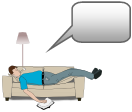
मैंने अख़बार पढ़ा mainne akhbaar parhaa
- I read the newspaper
Great! So now suppose we wanted to make this sentence a little more interesting and say “after eating I read the newspaper” - how would we do this? Well it’s easier than you might think! All we do is take the verb खाना khaanaa - ‘to eat’ and change it to खाकर khaakar - ‘after eating’, and then wack it into the start of our sentence…
मैंने खाकर अख़बार पढ़ा mainne khaakar akhbaar parhaa
- After eating I read the newspaper
Can you see whats happened? Let’s look at a few more examples to get more used to it….
Suppose this time we wanted to say “after speaking I got up”. How would we do this? Well we know how to say “I got up” - that’s just मैं उठा main uthaa, and as we’ve just seen above to say “after speaking” we say बोलकर bolkar. With me? So all together it’s…

मैं बोलकर उठा main bolkar uthaa
- After speaking I got up
Are you following here? Great! One thing to note is that what we add to the sentence is not effected by the grammar at all - it’s completely independent. All this means is that if we take away what we’ve added the sentence should make perfect sense! Ready for another example?


हाथी चूहे को देखकर चिल्लाया! haathee coohe ko dekhkar cillaayaa
- After seeing the mouse the elephant screamed!
Still with me? Don’t forget you can ask in the comments section just below if you have any questions! We can use this construction with other tenses, not just the past tense, so we could say…

मैं उनसे पूछकर तुम्हें बताऊँगी
main unse poochkar tumhen bataaoongee
- After asking him I will tell you (said by a female).
Often in more causal conversations we add के ke instead of कर kar to the verb, these both have the exact same meaning just के ke is less formal…

राहुल अपनी चाय पीके घर जा रहा होगा raahul apnee caay peeke ghar jaa rahaa hogaa
- After drinking his tea Rahul will be going home.

सोके कुछ खाओ soke kuch khaao
- After sleeping eat something!
The verb करना karnaa in this construction always takes के ke and never कर kar, for example…

बहस करके मैं रोया bahas karke main royaa
- After arguing I cried.
Okay just one last thing to learn and then that’s it, promise! In Hindi if we want to say “I did something and then did something else” we usually use this construction. So we might say…

निकीता ने कैक बनाके खाया
nikieeta ne kaik banaake khaayaa
- Nikita made a cake and ate it.
Can you see we’re literally saying “Nikita, after making a cake, ate it”. With me still? One final example for today…

बैठकर मुझे दिखाइए baithkar mujhe dikhaaie
- Please sit down and show me
Phew ok wow! Well done if you’ve make it all the way through today’s lesson, sorry its been so long. Read though the lesson again and make sure you can understand each example - if not then please just ask in a comment below!
If you think you’ve understood everything then try translating these sentences into Hindi - go on, give it a go! Leave your answers in a comment and I’ll let you know how well you’ve done.
- After swimming I will go home.
- He came in and screamed!
- Priti saw a dress and bought it.
- Come home and clean your room.
- After reading my book I went to sleep
No comments:
Post a Comment